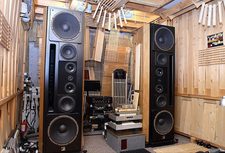It’s the time of year for saving money!
If you read through the various audio forums online you will discover one universal truth that spans from the most hardcore graph-reading specs-o-phile to the farthest far-out transcendental subjectivist is that they all love “negative” equipment reviews which highlight all the bad stuff about a piece of gear. Of course the problem nowadays is that even budget-priced high-performance audio gear is just that – high performance, so finding nits to pick at is much harder than in the “golden age” when Harry Pearson merely had to turn most “high-end” gear on to find their flaws.
 So in the interests of increasing reader pleasure I’ve put together a brief list of ways that anyone can, even in the privacy of their own home, (but I’ve also heard many of these methods employed at HiFi shows) arrive at a system that has noticeable sonic flaws that you may claim are the result of a poorly-made piece of gear. Try any or all of them – they work GREAT!
So in the interests of increasing reader pleasure I’ve put together a brief list of ways that anyone can, even in the privacy of their own home, (but I’ve also heard many of these methods employed at HiFi shows) arrive at a system that has noticeable sonic flaws that you may claim are the result of a poorly-made piece of gear. Try any or all of them – they work GREAT!
1. Put together an environment where everything sounds bad – This one is pretty easy and a majority of homes have one room that you could shoehorn a too-big speaker system into. The other extreme is to try to fill a large highly reflective room with sound via a small speaker. Overdrive the poor thing and even the best transducer will sound sub-par. Or if you’re feeling lazy and want immediate gratification, place any system in a room with at least two walls of glass or other highly reflective surfaces.
2. Combine the component with other components that do not work well together – I see this all the time at shows, usually caused by a marriage of convenience between two manufacturers whose equipment doesn’t mate well. Putting 95 dB efficient speakers together with a 500watt per side sound-reinforcement amplifier would be an example of a mismatch. Or you could try driving an 84 dB/1 watt efficient speaker with a 5-watt single-ended tube amplifier. This is best done at night so you can fully enjoy the fireworks.
 3. Play your music too loudly – If the volume on your system is turned up enough there is a point at which either your loudspeakers or your room will begin to distort. I’ve heard this with $100 and with $1 million dollar systems. It doesn’t matter how big or expensive your stereo is, you can make it sound like crap with the turn of a knob. This works with any system.
3. Play your music too loudly – If the volume on your system is turned up enough there is a point at which either your loudspeakers or your room will begin to distort. I’ve heard this with $100 and with $1 million dollar systems. It doesn’t matter how big or expensive your stereo is, you can make it sound like crap with the turn of a knob. This works with any system.
4. Make a component perform a task for which it was not intended – An obvious one is trying to drive a pair of “efficient” speakers from the headphone amp output on your pre/pro or receiver. Or try driving two rooms from a single RCA output from the back of your pre-pro. Using a high-power headphone amplifier with 110 dB sensitive in-ear monitors is another common missssssssssss-match. Hiss much, you bet!

5. Lambast a component because it does not include a feature only a small percentage of listeners use – This used to happen more in home-theater product reviews where a particular component did not have the latest-greatest DTS/DD/HDMI interface. It happens today primarily with DACs that don’t do all formats currently available (even if only available in minute quantities). For some audio reviewers any DAC that won’t do Quad DSD is trash.
6. Set a component up incorrectly – This is relatively easy if you have an aversion to reading owner’s manuals. You can even, on occasion, hook up something so improperly that it can destroy something further down the signal chain, as I did recently when I hooked up a pre/pro that was in fixed output mode when it should have been in variable output mode – 2 volts into a power amp was easily sufficient to destroy the speakers hooked up to the amp.
7. Use test material that is flawed (but the reviewer doesn’t know that) – Sometimes the source used to evaluate a system is the principle fidelity-limiting factor. Very few audiophiles know the complete provenance of their test tracks. The phenomenon of “I never heard THAT before” is a two-edged sword – higher resolution can reveal problems in source material that were heretofore unheard and these problems can be laid at the feet of the component under test rather than with the imperfections on the source material.
 8. Bring along strong personal biases – Anyone with a strong negative or positive bias toward a particular technology can create a system that favors a particular technology and handicaps those components that don’t “get with the program.” A room designed and configured for flat panel or open-baffle speaker designs can put a more conventional dynamic driver speaker at a disadvantage because it was not set up for that kind of speaker, and it will not perform optimally in such a space.
8. Bring along strong personal biases – Anyone with a strong negative or positive bias toward a particular technology can create a system that favors a particular technology and handicaps those components that don’t “get with the program.” A room designed and configured for flat panel or open-baffle speaker designs can put a more conventional dynamic driver speaker at a disadvantage because it was not set up for that kind of speaker, and it will not perform optimally in such a space.
So, there you have it – eight ways to generate negative opinions about any audio system. Perhaps you also have some favorite “system killing” ideas of your own, but maybe you should save them for your next negative review.





